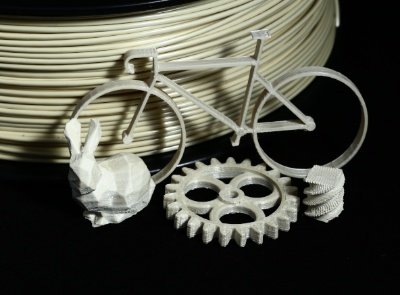3D printing inspired by nature – next steps for lightweight materials
- 10/15/18 9:40 AM
- Kirsten Oswald
Researchers at ETH Zurich develop bioinspired approach to 3D print recyclable liquid crystal polymers

3D printing is a promising technology in manufacturing industry, as objects with almost any shape and geometry can be designed. Researchers from ETH Zurich have developed a new method to 3D print recyclable liquid crystal polymers (LCP) that mimic the structure of natural materials. This new material not only outcompetes state-of-the-art printed polymers, but it also contends with the highest performance lightweight materials. As this approach uses a readily available polymer and a commercial desktop printer, its application can be extended to digitally design and manufacture strong and lightweight objects. Therefore, this technology is expected to be a game-changer for several structural and biomedical applications where weight or design are important drivers. Additionally, it could unlock new potentials for making vehicles lighter and reduce their energy consumption as well as lead to a more sustainable manufacturing industry due the recyclability and design freedom offered by 3D printing of LCPs.
3D Printing makes it possible to produce unique complex parts quickly and at a low cost by sequentially depositing beads of a molten polymer. However, the available polymers are relatively weak and the printed parts show poor adhesion between the printed lines. Because of these limitations, 3D printing has not yet been successfully implemented in commercial products. Traditionally, the performance of polymers was increased by including strong and stiff continuous fibers such as glass or carbon fibers into the material. Although the resulting materials exhibit very high strength and stiffness, the energy- and labor-intensive fabrication process as well as the difficulty to recycle advanced composites represent major challenges today. 3D printing with continuous fibers can create parts with more complicated geometries with good mechanical properties but this approach requires expensive specialized equipment, is still restricted to simple shapes and cannot be recycled.
For the first time, researchers from the Complex Materials group and the Soft Materials group at ETH Zurich were able to print objects from a single recyclable material with mechanical properties that surpass all other available printable polymers and can compete even with fiber-reinforced composites. The researchers were inspired by two materials that can be found in nature – spider silk and wood – during the development of these structures. Spider silk gets its unrivalled mechanical properties from the high degree of molecular alignment of the silk proteins along the fiber directions. It was possible to reproduce this high alignment by using a liquid crystal polymer (LCP) as feedstock material resulting in unprecedented mechanical properties in the deposition direction. Additionally, the anisotropic fiber properties were utilized by tailoring the local orientation of the print path according to the specific loading conditions imposed by the environment. This design principle is inspired by the ability of living tissue like wood to arrange fibers along the stress lines developed throughout the loaded structure as it grows and adapts to its environment (see figure below).

The 3D printed LCP structures are much stronger than the most advanced 3D printed polymers and do not require the labor- and energy-intensive steps involved in current composite manufacturing technologies. The freedom in design that comes with using a 3D printer can be used to create more complicated geometries with complex print line architectures. Combined with the fact that these printed structures can be recycled, it should finally be possible to create structures that can be used as lightweight structural parts. Its industrial implementation may ultimately lead to lowering energy consumption not only during the fabrication process, but also if applied as structural components to make vehicles lighter.
This work has been published recently in the Nature article “Three-dimensional printing of hierarchical liquid-crystal-polymer structures”. It is part of the PhD thesis of Silvan Gantenbein (Complex Materials group, ETH Zurich) and part of the research activities of SCCER Mobility Capacity Area A3. For further information, contact Silvan Gantenbein or Dr. Kunal Masania.
ETH News for Industry video.
!!! This document is stored in the ETH Web archive and is no longer maintained !!!